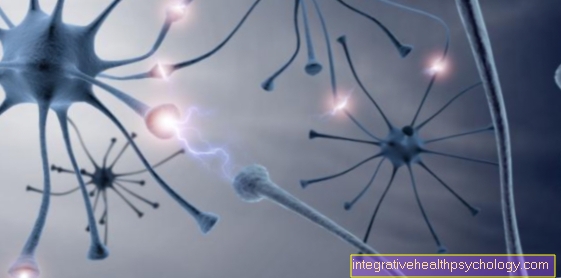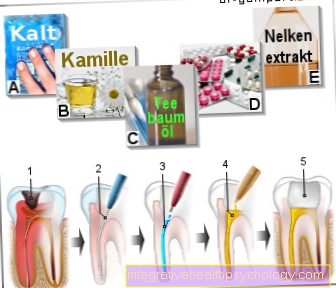Abscess on the head
definition
An abscess on the head is defined as an encapsulated collection of pus. Due to various causes, a so-called abscess cavity is created, which is separated from the surrounding tissue, for example muscle, by a type of capsule. Inside this capsule is pus, which consists of bacteria and dead cells, as well as white blood cells, so-called lymphocytes. The abscess can break through and empty into the surrounding tissue. This is a dangerous complication of the abscess. Abscesses on the head can occur in different locations and thus trigger very different symptoms. The way they are treated also differs.

causes
The causes of abscesses on the head are very diverse. Scalp abscesses can occur due to pre-existing boils. These often arise without a particular cause. However, small wounds or injuries can encourage the entry of pathogens into the skin. People with immunodeficiency are at higher risk of developing an abscess on their head.
Abscesses that are deeper are special clinical pictures. These usually arise on the basis of another inflammation. For example, an abscess of the tonsils develops due to a bacterial inflammation of special glands. This is favored by smoking and poor oral hygiene, but can also occur after an almond operation. Throat wall abscesses are often caused by bacterial inflammation of the lymph nodes.
Brain abscesses arise in different ways. Pathogens such as otitis media, sinusitis or tooth infection can get into the brain directly due to the confined space and cause an abscess there. Furthermore, pathogens can be passed through the blood into the brain. This can happen as part of sepsis, for example in the case of heart valve inflammation or pneumonia. Finally, brain abscesses can also result from injuries to the skull or as complications after neurosurgical interventions.
diagnosis
The diagnosis of an abscess on the head can be made using a variety of diagnostic tools. On the one hand, the anamnesis, i.e. the patient interview, forms an important basis for making the diagnosis. The typical symptoms of an abscess, such as fever, general exhaustion, pain, as well as swelling and redness, for example, are groundbreaking in diagnostics. However, if the abscess is deeper into the tissue, it is often not visible from the outside.
Imaging examinations, such as a CT or MRI, can make the abscess visible, for example in the jaw or neck. Ultrasound can also help identify an abscess. An abscess should not be punctured as this creates the risk of it breaking through. Taking a blood sample with determination of the inflammation values, CRP and leukocytes, is also groundbreaking, as these are usually increased in an abscess.
Symptoms
The symptoms of an abscess on the head can vary greatly depending on the type of abscess. In general, abscesses lead to fever, pain and a general feeling of fatigue. Depending on the location, however, there are special symptoms that are caused by the pressure on the surrounding tissue. Abscesses that are located in the throat, for example, lead to extreme pain when swallowing, swelling of the throat and neck, a torticollis and a decrease in appetite.
Furthermore, an almond abscess leads to a characteristic, lumpy language. Abscesses in the brain, on the other hand, express themselves through completely different symptoms. Most symptoms of a brain abscess tend to develop over a longer period of time. These include headaches, nausea and vomiting, epileptic seizures, fever and symptoms of paralysis, and drowsiness. For example, a sinus abscess can put pressure on the eye socket, causing blurred vision and double vision. Superficial abscesses of the scalp, on the other hand, lead to local pain, redness and bulging swelling of the scalp. A fever can also occur.
therapy
Treatment for an abscess on the head depends on the type of abscess. A superficial skin abscess is usually opened with a stab incision and emptied. In the case of pronounced symptoms such as fever and nausea, an antibiotic may also be necessary. Abscesses that are deeper, however, require special surgical and antibiotic therapy. These include, for example, throat abscesses. These must always be operated on and additionally treated with antibiotics. Such an operation takes place under general anesthesia.
A combined antibiotic therapy consisting of three antibiotics, usually penicillin, gentamicin and clindamycin, is always used in order to cover a broad spectrum of pathogens. In uncomplicated cases, an abscess of the tonsils can often only be treated with antibiotics, whereby so-called aminopenicillins with penicillinase inhibitors are used. This includes, for example, amoxicillin with clavulanic acid. However, if there is no improvement with this antibiotic therapy, an operation must also be carried out here.
Brain abscesses always require antibiotic and surgical therapy. Antibiotic therapy for a brain abscess lasts between 4 and 8 weeks. A combination of a cephalosporin antibiotic, such as ceftriaxone, with metronidazole and vancomycin is always used first. After identifying the pathogen and testing for resistance, the antibiotic therapy is then adjusted. Various surgical procedures are available for surgical treatment, depending on the location of the abscess and the general condition of the person concerned.
Read more on the subject at: Treatment with antibiotics
Duration
An abscess on the head can last different times. This depends, among other things, on the location of the abscess and the treatment. Abscesses usually develop acutely to subacute within a few days. Treatment is then usually sought with an incision and surgical removal of the abscess.
This treatment results in immediate removal of the abscess, but in some cases it can be difficult to achieve immediate healing. Sometimes abscesses come back, so they can go on for weeks.
Localization of the spread
up to the neck
There are different forms of abscesses that can extend into the throat. These include above all the peritonsilar and peripharyngeal abscess. The peritonsillar abscess can develop as a complication after a tonsil operation or if there is inflammation of special glands, the so-called Weber’s glands of the tonsils. It is more common in smokers and people with poor oral hygiene. Young people in particular are affected. Typical are severe sore throats and difficulty swallowing, as well as fever and unilateral tonsil swelling (see also: Swollen tonsils). Those affected still have a clumsy language. Such an abscess is always treated with antibiotics and can be operated on if it does not improve.
Peripharyngeal abscesses are abscesses that spread into the deep throat. These can result from a peritonsillar abscess or from inflammation of the lymph nodes. Both forms of this abscess must always be operated on, as they cannot be controlled with antibiotic therapy alone. This type of abscess also manifests itself as pain when swallowing, fever, and general weakness. Neck swelling can also occur.
At this point, the editors recommend the following article: Swelling of the lymph nodes on the neck
up to the neck
An abscess in the back of the throat, also called a retropharyngeal abscess, can cause painful neck swelling. This form of the abscess arises from a purulent inflammation of the pharyngeal lymph nodes and is an absolute indication for surgery. Typically, those affected cannot swallow because of pain, have a fever and usually even a torticollis due to the swelling. Small children are particularly affected, but the abscess can also occur in adults. A retropharyngeal abscess is always treated with antibiotics and an operative opening.
This article may also be of interest to you: Swelling of the lymph nodes in the neck

















.jpg)











